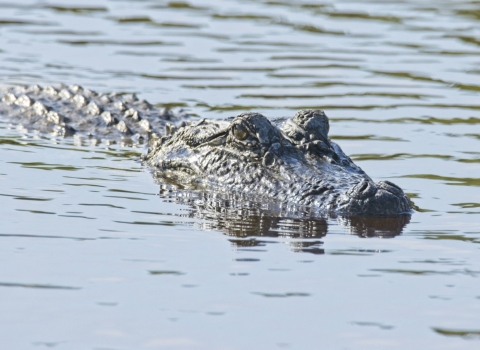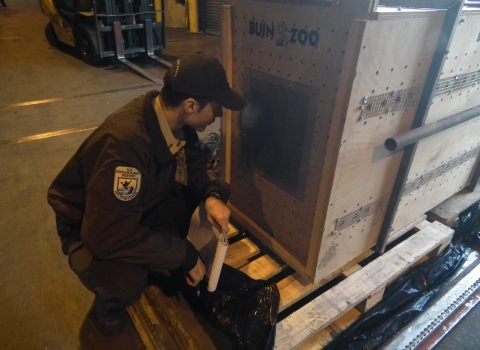PANAMA CITY, PANAMA – After working around the clock for two weeks, the Biden-Harris administration announced Friday it has forged critical agreements to ensure legal, traceable and biologically sustainable international trade of wild animals and plants. U.S. government leaders met with over 2,000 representatives from more than 150 nations, non-governmental organizations, industry and academia at the 19th meeting of the Conference of the Parties (CoP19) to the Convention on International Trade in Endangered Species of Wild Fauna and Flora (CITES), the world’s only forum on international trade in plants and wildlife.
Held November 14-25 in Panama City, Panama, the CoP19 and its participants took a strong stance to conserve a wide range of known and lesser-known species and improve CITES implementation on matters ranging from ending illegal trafficking in totoaba and restricting trade in live African elephants to ensuring conservation of marine turtles and curbing the illegal trade in cheetahs and jaguars.
The U.S. delegation to CoP19 was led by Department of the Interior Deputy Assistant Secretary for Fish and Wildlife and Parks Matthew J. Strickler, supported by U.S. Fish and Wildlife Service Director Martha Williams, Assistant Secretary of State for Oceans and International Environmental and Scientific Affairs and Special Envoy for Biodiversity and Water Resources Monica Medina, and the Service’s Assistant Director for International Affairs Bryan Arroyo. In addition to the Service, which is responsible for implementing CITES in the United States, delegation members included representatives from the U.S. Department of State, U.S. Department of Agriculture, U.S. Department of Justice, NOAA Fisheries, U.S. Agency for International Development, and the Association of Fish and Wildlife Agencies, as well as committee staff from the U.S. Senate.
“With 1 million species facing extinction around the world, international trade often represents the tipping point for wildlife already impacted by habitat loss and degradation, climate change climate change
Climate change includes both global warming driven by human-induced emissions of greenhouse gases and the resulting large-scale shifts in weather patterns. Though there have been previous periods of climatic change, since the mid-20th century humans have had an unprecedented impact on Earth's climate system and caused change on a global scale.
Learn more about climate change , invasive species invasive species
An invasive species is any plant or animal that has spread or been introduced into a new area where they are, or could, cause harm to the environment, economy, or human, animal, or plant health. Their unwelcome presence can destroy ecosystems and cost millions of dollars.
Learn more about invasive species or disease. No one country can solve these problems alone. Seeing nations come together and take a collaborative, strong stance for wildlife over the past two weeks gives me hope that together we can meet the challenge. I am very pleased with our outcomes,” said Deputy Assistant Secretary Strickler.
“If CITES is to be successful in preventing the extinction of species threatened by international trade, we need to continue prioritizing investment in capacity-building efforts,” said Service Director Williams. “CITES is only as strong as each of its member nations. As part of our commitment to CITES capacity-building efforts, we have supported regional cohorts to attend the CITES Masters Course at Spain’s Universidad Internacional de Andalucía in recent years. These emerging conservation leaders are the future of CITES, and many of the delegates who demonstrated outstanding leadership at CoP19 are graduates of this course. We will continue to support global efforts to increase the capacity of parties to implement CITES and ensure all voices are heard in this critical forum.”
Notable at CoP19 were the strong voices advocating for increased protection for native species. For the U.S. delegation, increased protection for U.S. native reptiles included CITES listing of 36 species of U.S. native turtles, which are under increasing demand from East Asia and Europe. Biological and life history traits make freshwater turtles and tortoises highly vulnerable to exploitation. The turtle trade follows a boom-and-bust pattern, in which exploitation in one species shifts to another as species become depleted to a level where they can no longer be commercially exploited or when it becomes subject to stricter regulations. The CITES Appendix-II listing of alligator and common snapping turtles, all map turtles, all mud turtles except for the two species already included in Appendix I, all musk turtles, and all soft-shelled turtles (Apalone species), will complement U.S. state management efforts, reduce the risk of overharvesting, and support biologically sustainable use and legal and traceable international trade in U.S. native turtles.
The United States also co-proposed the inclusion of glass frogs in Appendix II, alongside Costa Rica, Argentina, Brazil, Cote d’lvoire, Dominican Republic, Ecuador, El Salvador, Gabon, Guinea, Niger, Panama, Peru and Togo – a proposal that passed by consensus Friday. Glass frogs have unique transparent skin on their underside, showing their bones and internal organs. International demand for glass frogs in the exotic pet trade adds to the numerous threats they already face, including habitat loss and fragmentation, climate change, invasive species and diseases such as chytrid fungus. In the U.S., demand for glass frogs in the pet trade has increased exponentially, from 13 live individuals imported in 2016 to 5,744 individuals in 2021. Individual glass frog species are difficult to tell apart. Including the entire genus in Appendix II is a critical step in ensuring that international trade does not represent an added threat to wild populations.
The United States proposed strong measures to enforce CITES provisions to end illegal fishing and trafficking in totoaba and ensure survival of the critically endangered vaquita, which now numbers 10 or fewer individual animals and is at imminent risk of extinction. Despite its protected status, the totoaba suffers from illegal fishing that has continued in Mexico’s Upper Gulf of California to meet demand for its swim bladder in East Asia. Without an end to this illegal fishing, vaquita will continue to be caught and drown as bycatch. Working closely together over the past two weeks, the U.S. and Mexico agreed on a way forward to curb illegal fishing of totoaba, taking into consideration the concerns expressed by Mexico as well as the need to act immediately to avoid the vaquita’s extinction. Parties supported their joint decision by consensus.
The Biden-Harris administration is committed to ensuring transparency and inclusiveness in CITES implementation and preparation for CITES meetings, in particular CoPs. The Service began its public participation process to gather and evaluate information related to species involved in international trade and improving implementation of the convention more than two years ago, culminating in the submission of 14 species proposals and six documents the U.S. advanced or co-sponsored to be considered by CITES member nations at CoP19.
For more information on CoP19 and these outcomes, please visit our CITES CoP19 page.






